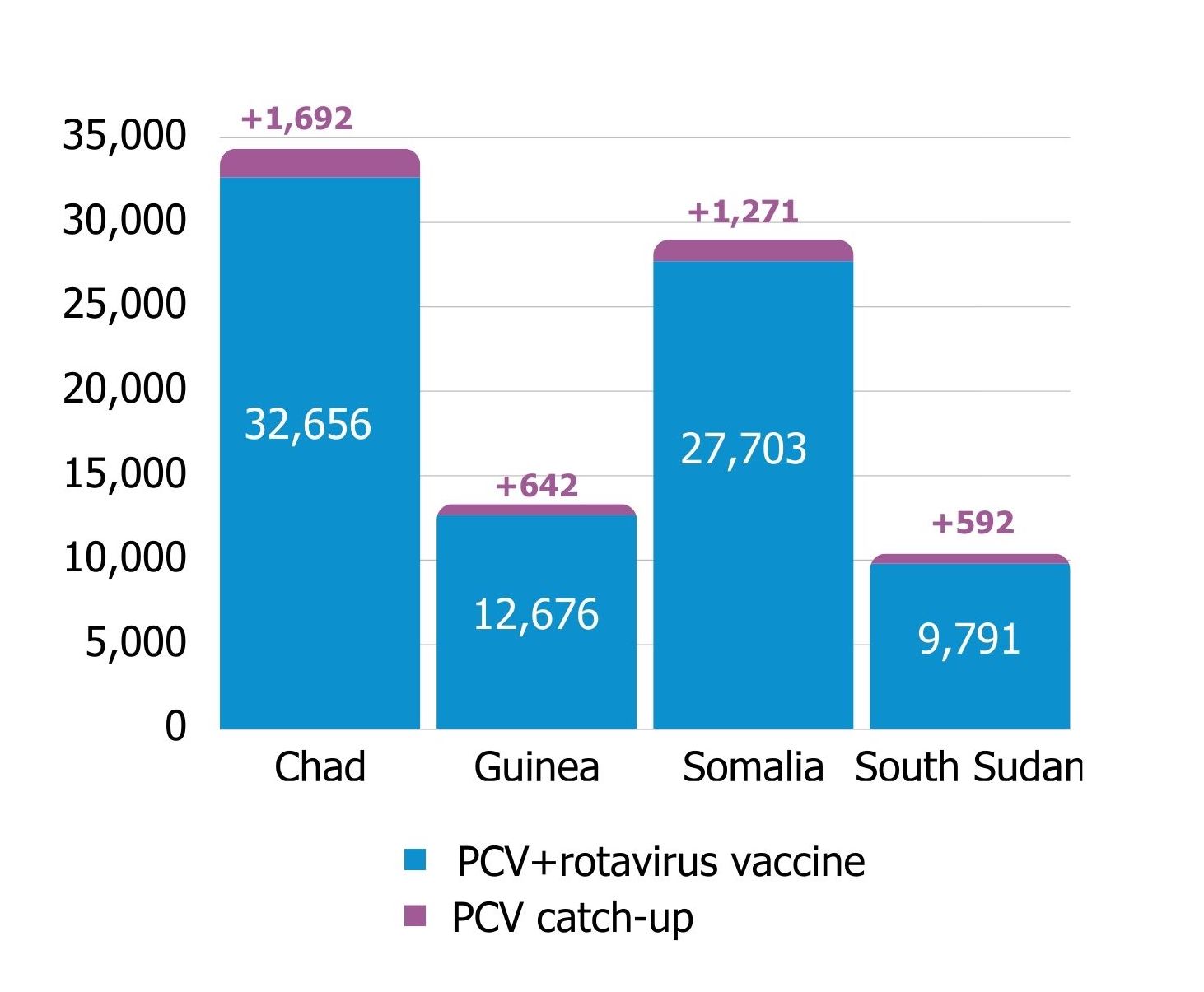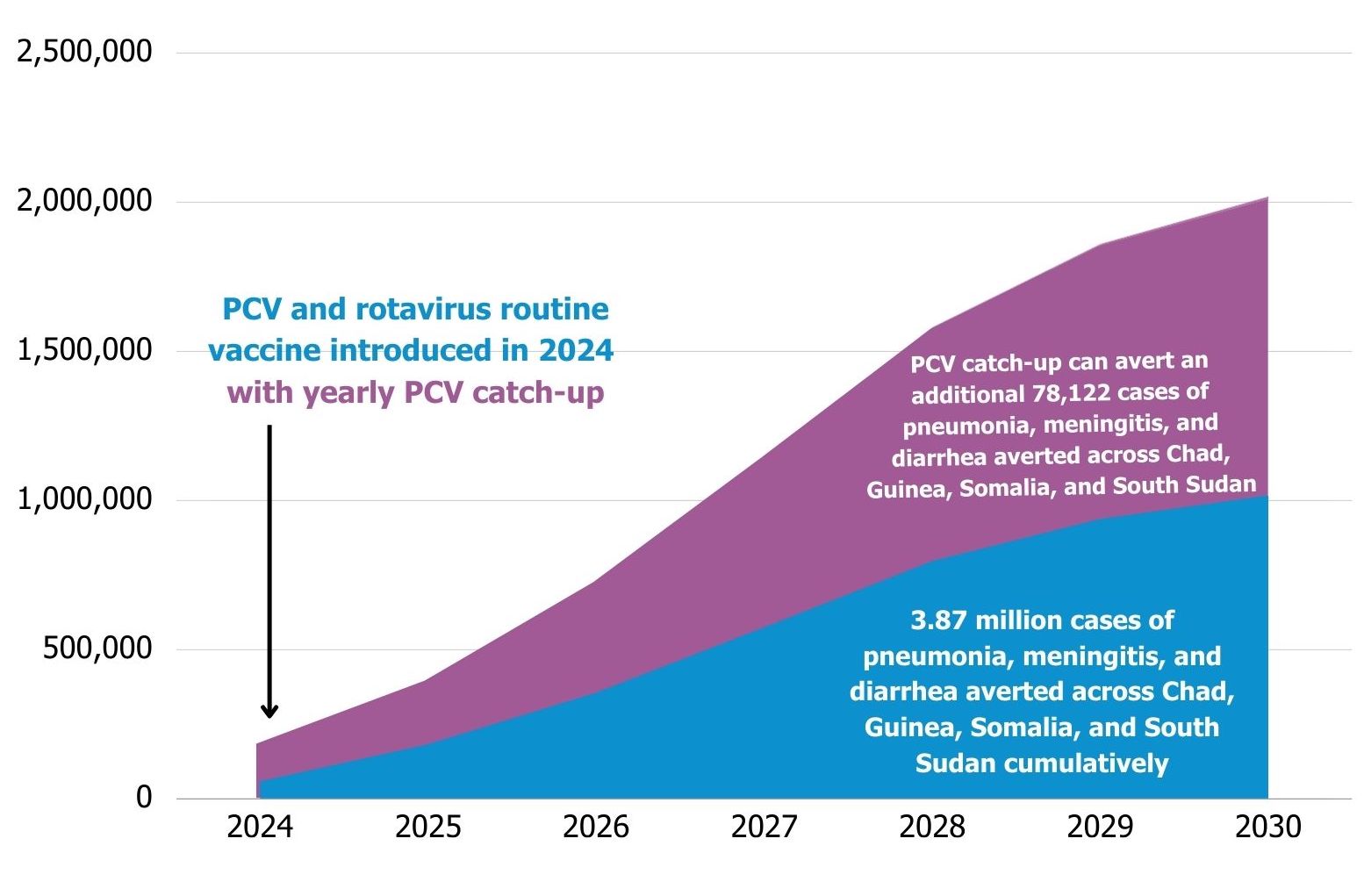
The Impact of Introducing Rotavirus and Pneumococcal Conjugate Vaccine (PCV) in Chad, Guinea, Somalia and South Sudan

Two young children await their doses of the pneumococcal conjugate vaccine (PCV) in Rwanda. It is the hope that children under the age of five in Chad, Guinea, Somalia and South Sudan will soon get the opportunity to get their doses of the PCV as well as Rotavirus. Photo: John Hopkins Bloomberg School of Public Health/IVAC International Vaccine Center.
Pneumonia and diarrhea continue to be leading infectious causes of childhood mortality, claiming the lives of an estimated 1.3 million children under the age of five each year. These diseases cast a long, ominous shadow over child health, especially in regions grappling with multiple challenges, from high child mortality rates to disease outbreaks, geopolitical instability, and climate-related disasters.
The profound scale of these challenges becomes even more apparent when we focus on the unique hardships faced by countries like Chad, Guinea, Somalia, and South Sudan. Across the four countries in 2017, approximately 43,000 children died from acute lower respiratory infections and 24,000 children died from diarrheal diseases. Globally, pneumonia and diarrhea account for approximately one-third to nearly half of all under-5 child deaths, demonstrating the substantial burden of these diseases on child mortality in these regions and underscoring the pressing need for decisive action, including the urgency of incorporating PCV and rotavirus vaccines into national immunization schedules.
Using the Lives Saved Tool (LiST), a modeling system that estimates the impact of health interventions on mortality and morbidity, a team of researchers from the Johns Hopkins Bloomberg School of Public Health estimated that introduction and scale-up of PCV and rotavirus vaccines could save over 80,000 lives of children under age five and prevent nearly four million cases of childhood pneumonia, meningitis, and diarrhea in Chad, Guinea, Somalia, and South Sudan between 2024 and 2030.
 Potential lives saved of children aged 1 month to 59 months cumulatively from 2024 to 2030 with PCV + PCV catch-up + rotavirus vaccine from 2024 to 2030. Photo: John Hopkins Bloomberg School of Public Health/IVAC International Vaccine Center.
Potential lives saved of children aged 1 month to 59 months cumulatively from 2024 to 2030 with PCV + PCV catch-up + rotavirus vaccine from 2024 to 2030. Photo: John Hopkins Bloomberg School of Public Health/IVAC International Vaccine Center.
 Potential cases of severe pneumonia, meningitis, and diarrhea averted with PCV + PCV catch-up + rotavirus vaccine per year across Chad, Guinea, Somalia and South Sudan. Photo: John Hopkins Bloomberg School of Public Health/IVAC International Vaccine Center. These figures represent more than numbers; they represent a beacon of hope by promising a healthier childhood for countless children, and it is critical to leave no child behind. When children miss vaccines for reasons related to the family, the health system, and social factors, catch-up vaccination plays a crucial role. Catch-up vaccination refers to the action of vaccinating someone who may have missed their earlier vaccinations but are eligible as per their country’s national immunization schedule to receive these lifesaving immunizations. Organizations such as the World Health Organization (WHO), UNICEF, and Gavi, The Vaccine Alliance emphasize the significance of catch-up vaccinations, especially in areas with high disease burdens.
Potential cases of severe pneumonia, meningitis, and diarrhea averted with PCV + PCV catch-up + rotavirus vaccine per year across Chad, Guinea, Somalia and South Sudan. Photo: John Hopkins Bloomberg School of Public Health/IVAC International Vaccine Center. These figures represent more than numbers; they represent a beacon of hope by promising a healthier childhood for countless children, and it is critical to leave no child behind. When children miss vaccines for reasons related to the family, the health system, and social factors, catch-up vaccination plays a crucial role. Catch-up vaccination refers to the action of vaccinating someone who may have missed their earlier vaccinations but are eligible as per their country’s national immunization schedule to receive these lifesaving immunizations. Organizations such as the World Health Organization (WHO), UNICEF, and Gavi, The Vaccine Alliance emphasize the significance of catch-up vaccinations, especially in areas with high disease burdens.
Using the LiST tool, we estimated an additional 4,197 children under age five can be saved across Chad, Guinea, Somalia and South Sudan if an annual PCV catch-up strategy was implemented alongside routine PCV and rotavirus vaccination, raising the number of lives saved to 87,023. It could also avert a further 78,122 cases of pneumonia, meningitis, and diarrhea across the four countries raising the number to 3.95 million cases averted.
These estimates are more than just calculations; they are a call to action. They become a rallying cry for these life-saving vaccines to be integrated into the national immunization schedules of Chad, Guinea, Somalia, and South Sudan. The commitment of these countries to prioritize these vaccines, as outlined in the Declaration of Commitments from the 2nd Global Forum on Childhood Pneumonia in April 2023, signifies a pivotal step towards securing the well-being of children. The introduction of PCV and rotavirus vaccines in these four countries would bring hope for a healthier and brighter future for children. As researchers, practitioners, policy-makers and parents it is up to us to ensure that children everywhere receive the protection they deserve.
For more detailed information on these findings, you can explore our comprehensive two-pager brief here: Estimating the impact of new vaccine introduction in Chad, Guinea, Somalia, and South Sudan


